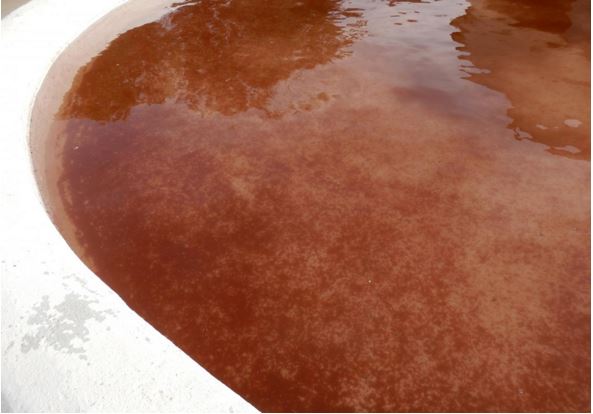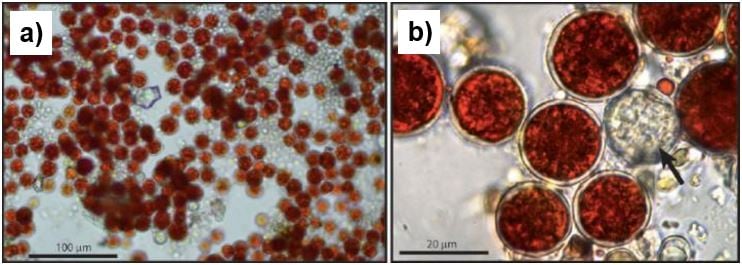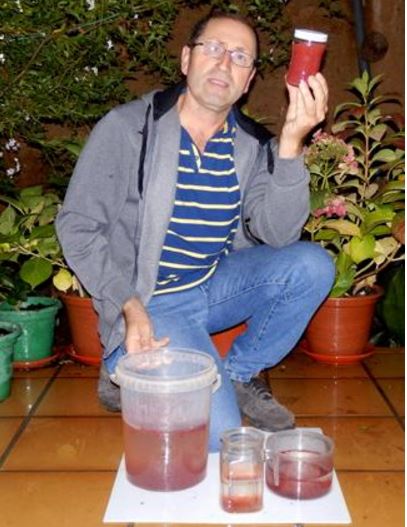A blood rain downpour in the autumn of 2014, that shocked the inhabitants of several villages around Zamora in northwest Spain, was caused by a strange, green microalgae, and was not a punishment for sins committed, a prelude to a disaster of Biblical proportions, or something originating from outer space, say scientists from the University of Salamanca.
The green microalgae turns a reddish color when in a state of stress. Microalgae, also known as microphytes, are microscopic algae generally found in marine and freshwater systems, living both in the water column and sediments.
Although the scientists can explain what organism caused the blood rain, they are still unable to identify the mysterious origin of the microalgae, which are also present in the automotive, food and pharmaceutical industries.
 The water in this basin in Fuente Encalada was stained red due to the presence of the microalgae Haematococcus pluvialis, brought by the rain. (Image: eurekalert.org. Credit: Joaquín Pérez)
The water in this basin in Fuente Encalada was stained red due to the presence of the microalgae Haematococcus pluvialis, brought by the rain. (Image: eurekalert.org. Credit: Joaquín Pérez)
Some wondered whether airplanes were dumping chemicals
Last year, residents of Fuente Encalada in Zamora were astounded to see how the water in the white basins became red. Some wondered whether anybody had spilled something into the basin, or perhaps airplanes had been dumping stuff from the sky. A significant minority of the population started quoting the Biblical plagues.
The news travelled rapidly to Ayoó de Vidriales, a neighboring village, where Joaquín Pérez lived. He decided to collect some rainwater in order to monitor this phenomenon through that autumn plus the winter that followed.
It soon became clearly evident that some small particles that appeared both at the bottom of the containers and along their edges were staining the water red.
Mr. Pérez sent samples to scientists at the University of Salamanca, who published their findings in the Spanish Royal Society of Natural History Journal.
 (Left) A colony of microalgae Haematococcus pluvialis in a state of encystment and (Right) a close-up of the red color of the cell’s nucleus due to the production of astaxanthin. The black arrow points to a transparent specimen that does not possess the carotenoid. (Image: eurekalert.org. Credit: J. Fernández-Lozano et al. / USAL)
(Left) A colony of microalgae Haematococcus pluvialis in a state of encystment and (Right) a close-up of the red color of the cell’s nucleus due to the production of astaxanthin. The black arrow points to a transparent specimen that does not possess the carotenoid. (Image: eurekalert.org. Credit: J. Fernández-Lozano et al. / USAL)
The culprit – Haematococcus pluvialis
Co-author, geologist Javier Fernández-Lozano, said:
“The reddish staining is caused by Haematococcus pluvialis, a freshwater green microalgae that is capable of synthesizing a red carotene pigment called astaxanthin when in a state of stress.”
Scientists are able to observe the complex life cycle of these unicellular algae using light microscopy. During some stages they can move using flagella (a tail-like structure). Sometimes, if conditions are unfavorable, they form cysts and turn red.
When they form cysts, the red color is even more visible against white backgrounds, especially in the presence of sunlight.
 Blood rain samples gathered by Joaquín Pérez. (Image: eurekalert.org. Credit: Joaquín Pérez)
Blood rain samples gathered by Joaquín Pérez. (Image: eurekalert.org. Credit: Joaquín Pérez)
How did Haematococcus pluvialis get to Zamora?
This microalgae is known to exist in water bodies in the Northern Hemisphere, especially along the European Atlantic seaboard and North America. However, they are not generally found in peri-Mediterranean environments, such as Zamora.
Fernández-Lozano added:
“What is interesting is that we have confirmed that this species does not appear in Sanabria Lake or in the reservoirs surrounding the village of Ayoó de Vidriales. So they must be coming from some other place.”
In their quest to determine where this species originated, the scientists analyzed meteorological data, including wind patterns, corresponding to the days when it ‘rained blood’.
Their analysis showed a connection to prevailing westerly winds that would have affected the north-western region of the Iberian Peninsula during the autumn of last year.
However, the researchers were not able to identify exactly where these microorganisms originated. They may even have come from North America, the authors wrote.
Several industries use this microalgae
Over recent years, the use of Haematococcus pluvialis has spread to the pharmaceutical industry because of its antioxidant properties. It has also been used as a source of food for salmon and trout in fish farms to enhance their color.
Flamingos owe their pinkish hue to these non-toxic algae.
Japanese motorcycle maker Yamaha has recently found a way to reduce carbon dioxide (CO2) emissions in its factories by using these microscopic algae. The company managed to do this by injecting CO2 into huge Haematococcus pools.
Some genera of microalgae that exist in the sea are responsible for the red tides that are sometimes observed in estuaries and coastal areas across the globe. Blood rain, on the other hand, is a much rarer occurrence than these red tides.
The best-known occurrence of blood rain was in Kerala, India in 2001. Other occurrence were later witnessed in southern India and Sri Lanka. Scientists confirmed that in those cases the culprit was the algae Trentepohlia, and ruled out suggestions from alien enthusiasts that they could have come from elsewhere in the Universe.
Citation: “Revealing the presence of Haematococcus pluvialis (Flotow,1844) in Zamora province (Haematococcaceae),” Javier Fernández-Lozano, Antonio Guillén-Oterino, Gabriel Gutiérrez-Alonso, José Abel-Flores y Joaquín Pérez-Turrado.. Bol. R. Soc. Esp. Hist. Nat. Sec. Biol. 109: 103-109, 2015.
Video – Haematococcus pluvialis
